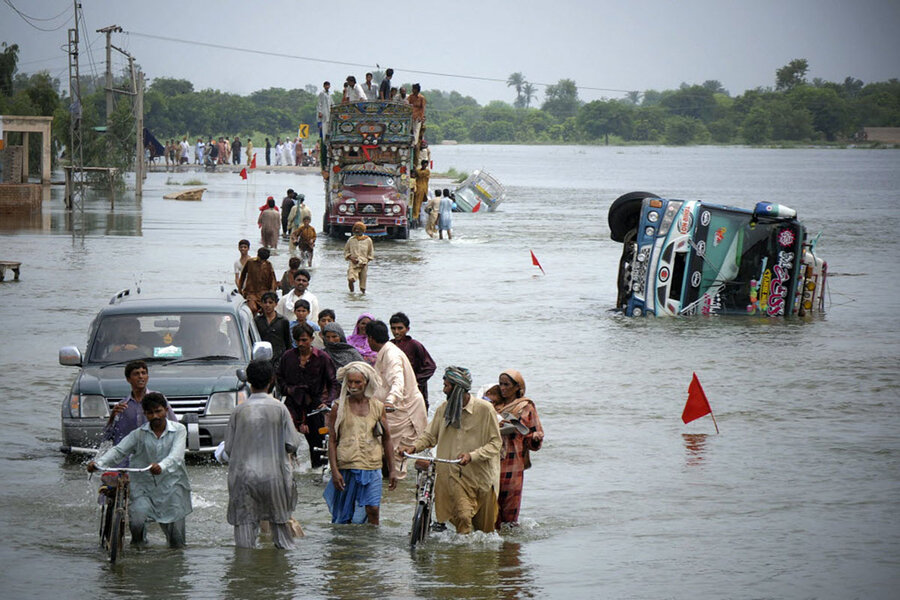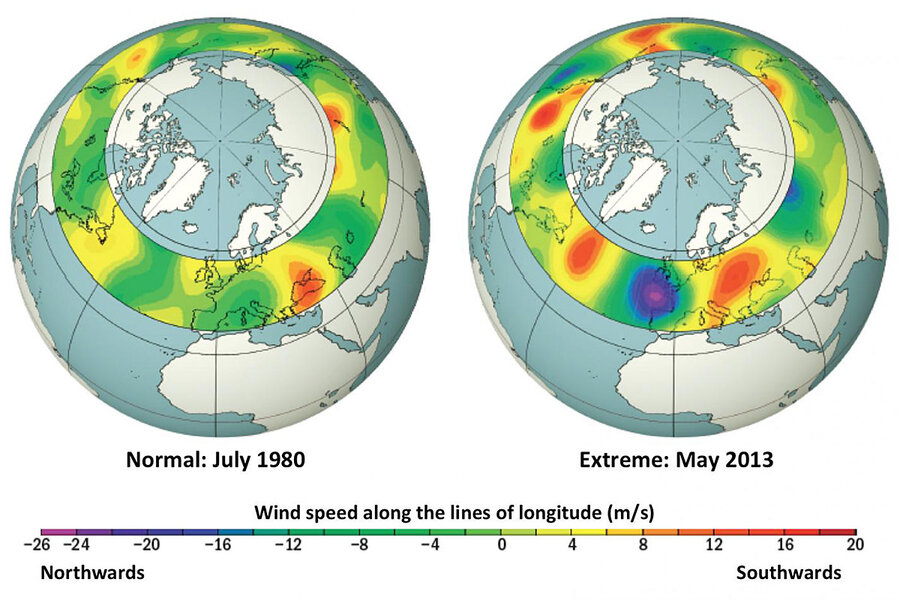How climate change may be driving extreme weather
Loading...
Whether a specific extreme weather event can be linked to climate change rarely gets a straightforward answer from climate scientists or meteorologists. It's complicated, they'll say, but that doesn't mean there isn't a relationship.
"Climate scientists have been willing to link the general increase in certain types of weather extremes (heat waves, droughts, and floods) to climate change in a generic sense," says Michael Mann, an atmospheric scientist at Pennsylvania State University. Rising global temperatures and other climate forces can certainly change the conditions that underlie weather, which climate scientists have said can lead to a change in the frequency of a type of weather event.
But Dr. Mann and colleagues report that there is a more direct way that climate change is impacting weather extremes: by altering the movement of the jet stream.
"Our work shows that climate change isn’t just leading to more extreme weather through the usual mechanisms that have been described in the literature (warmer temperatures means more heat waves, hotter summers mean worse drought, warmer atmosphere holds more moisture so when it rains or snows we tend to see greater amounts of precipitation)," Mann writes in an email to The Christian Science Monitor. "We show that, in addition to those effects, climate change is changing the behavior of the jet stream in a way that favors more extreme persistent weather anomalies."
And, in a paper published Monday in the journal Scientific Reports, Mann and his colleagues suggest that this climate change-driven shift in the jet stream influenced the 2003 heat wave in Europe, flooding in Pakistan and a heat wave in Russia simultaneously in 2010, and the Texas heat wave in 2011.
"This study convincingly demonstrates a mechanism connecting climate change with extreme weather during summer over Northern Hemisphere continents, affecting billions of people," Jennifer Francis, a climate scientist at Rutgers University in New Brunswick, N.J., who was not involved in the research, writes in an email to the Monitor.
The jet stream, which Mann describes as a "ribbon-like air current that travels eastward … in the lower part of the atmosphere where weather happens," exists because of the difference in air temperatures between the subtropic and subarctic regions.
The eastward-flowing air isn't one completely steady band. Slow-moving waves that travel from north to south often appear across the ribbon of air. It is those particularly large undulations, called Rossby waves, that researchers link with extreme weather, because of the intensely low or high pressure systems they bring with them.
In a warming world, these Rossby waves are getting stuck in one place for a long period of time, Mann and his colleagues say. And this means that a region under the low pressure part of these waves will experience intense, prolonged rainfall resulting in flooding. The regions under the high pressure systems will be stuck with hot, dry conditions conducive to drought and wildfires.
What's making these waves static, or at least slowing them down? Mann points to the warming Arctic. The tropics aren't warming as much as the Arctic, so the temperature gradient from north-to-south is less extreme. As the temperature differences that create the jet stream decline, the jet stream's dynamics change.
This relationship was previously proposed by German climate researchers in 2013. But Mann and his colleagues have built on this idea by identifying a fingerprint related to these static, or particularly slow-moving, waves.
The researchers found that the pattern of these fingerprints in the real-world data for recent extreme weather events matched simulations of the influence of anthropogenic greenhouse gases, indicating that climate change is indeed influential in altering the jet stream dynamics.
Kevin Trenberth, senior scientist in the Climate Analysis Section at the National Center for Atmospheric Research (NCAR) who was not involved in the research, cautions that teasing out the climate change signal from the noise of natural variability in a particular weather system can be tricky.
"Weather systems occur naturally, in terms of the storms themselves, the phenomena, etc.," he writes in an email to the Monitor. "But their impacts are undoubtedly altered by climate change: higher temperatures, heat waves, wildfires; stronger rains (and snows), more intense droughts, and further, the storms may be more intense."
Although the impact of climate change on the temperature, and rainfall intensity is undoubtable, Dr. Trenberth says, the causal relationship is less clear when considering the dynamics (the storms themselves and atmospheric waves) of a weather system.
"There is a no doubt that there are relationships, but it is not so clear what is the cause; i.e. the change in waves, the Arctic and so forth are all part of the same thing: and the change in Arctic is likely more a result not a cause," he writes.
Climate scientists and meteorologists have been hesitant to draw a direct link between extreme storms and climate change, although they say unusual weather is consistent with models of a changing climate. But Dr. Francis and David Easterling, chief of the Scientific Services Division of the National Oceanic and Atmosphere Administration’s (NOAA) National Centers for Environmental Information, who also was not involved in the study, say this research is eroding that hesitation.
"This work adds a substantial layer to the pile of research suggesting that climate change is already causing an increase in certain types of extreme weather events. Moreover, as society continues along the present path of unabated fossil fuel burning, weather will become even more extreme," Francis says.
"I think it certainly provides more evidence towards it," Dr. Easterling agrees in a phone interview with the Monitor. "Is it a definitive answer? No, not necessarily.... But it's beginning to draw that link."
"This is beginning to give you a dynamical meteorology reason why we may see more of these events," Easterling says. This research gives us an idea about the mechanism behind these changes, rather than just statistics, he says.
Mann and his team have focused their work on identifying the link in historical data, but the same technique could have applications in predicting future extreme weather from climate trends. "Indeed, that’s precisely the analysis we are doing now, performing a similar analysis but using instead the climate model projections for the next century," Mann says. "Stay tuned."
It's not just about long-term climate trends, Easterling adds. "If meteorologists that are actually doing forecasting can look at this and begin to see these patterns, they can do a better job of forecasting heatwaves and/or extended wet periods" in the nearer future as well.
Regardless of timescale, these sorts of predictions could help save lives and expense, Francis says. Extreme weather affects insurance costs, food security, and political stability, among other things, she says.
"Knowing the reason for the increased frequency of extreme summer weather events – such as heat waves, droughts, and floods – and knowing these events will become only more frequent and intense in the future, will inform decisionmakers and help leaders of governments and businesses to prepare for them," Francis says. "This knowledge, if acted upon, could save lives and [prevent] suffering."









